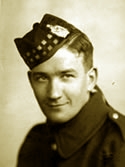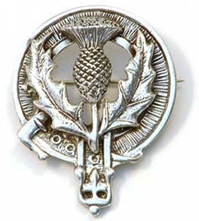|
Castle Dangerous is a
novel (1832) by Walter Scott. It is part of Tales of My
Landlord, 4th series. The castle the series is based on is
Douglas Castle. Douglas Castle was a stronghold of the
Douglas family from medieval times to the
nineteenth century. The first castle, erected in the 13th
century, was destroyed and replaced several times until the 18th
century when a large mansion house was built in its place. This
too was demolished in the 1938, and today only a single corner
tower of the 17th century castle remains.
The story is set in Ayrshire and Lanarkshire
around 1306, shortly after the death of William Wallace during
the Wars of Scottish Independence. Lady Augusta has promised to
marry Sir John de Walton provided that he can maintain
possession of the castle he has captured for a year and a day.
Regretting her promise, she resolves to travel in disguise to
the castle to find some method of subversion.
Anxious
to curtail this period, she determined to make her way thither,
accompanied by her father's minstrel, Bertram, disguised as his
son, and they were within three miles of their destination, when
fatigue compelled them to seek shelter at Tom Dickson's farm.
Two English archers, who were quartered there, insisted that the
youth (Lady Augusta in disguise) should be left at the
neighboring convent of St Bride's, until Bertram satisfied Sir
John as to the object of their journey, and this arrangement was
approved of by Sir Aymer de Valance, the deputy governor, who
arrived to visit the outpost. As they proceeded together towards
the castle, the minstrel entertained the young knight with some
curious legends respecting it, including the supernatural
preservation of an ancient lay relating to the house of Douglas,
and the future fate of the British kingdom generally. De Valance
would at once have passed the stranger into the stronghold as a
visitor; but the old archer Gilbert Greenleaf detained him in
the guard room until the arrival of the governor, who, in the
hearing of Fabian, Sir Aymer's squire, expressed his disapproval
of his deputy's imprudence, and thus the seeds of disagreement
were sown between them.
Sir
John, however, wished to be indulgent to his young officers, and
accordingly arranged a hunting party, in which the Scottish
vassals in the neighborhood were invited to join; but, at the
mid-day repast, a forester named Turnbull behaved so rudely to
the governor that he ordered him to be secured, when he suddenly
plunged into a ravine and disappeared. The young knight took
fresh offence at being ordered to withdraw the archers from the
sport to reinforce the garrison, and appealed to his uncle, the
Earl of Pembroke, who, instead of taking his part, wrote him a
sharp reproof. He then opposed the governor's wish that the
minstrel should terminate his visit, which induced Sir John to
threaten Bertram with torture unless he instantly revealed his
purpose in coming to the castle. The minstrel declined to do so
without his son's permission; and, the Abbot having pleaded for
delay on account of the boy's delicate health, Sir Aymer was
ordered to meet a detachment at an outpost, and then to bring
him to the castle to be examined. As he passed through the town
he encountered a mounted warrior in full armor, whom neither the
inhabitants nor his followers would admit having seen. The old
sexton, however, declared that the spirits of the deceased
knights of Douglas could not rest in their graves while the
English were at enmity with their descendants. On reaching the
convent, De Valence roused Father Jerome, and insisted that the
youth (Lady Augusta) should at once accompany him. He was,
however, allowed to return to his bed till daybreak, and upon
the door of his room being then forced open, it was empty.
During the night, Sister Ursula, who had hidden in the room,
elicited Lady Augusta's secret, which she had already guessed,
and, having narrated the circumstances under which she had
entered the convent without taking the vows, they escaped
through a concealed postern and found a guide with horses
waiting for them. A scroll which his lady-love had left behind
her explained matters to Sir John, who, in his despair, was
comforted by the sympathy of his lieutenant; and the faithful
minstrel, having been admitted to their confidence, steps were
at once taken to track the fugitives.
Having reached a
thicket, Sister Ursula (whose original name was Lady Margaret)
disappeared to join her friends, and Lady Augusta was escorted,
first by the celebrated Douglas, and then by Turnbull, to a spot
where they met Sir John, to whom the forester delivered a
message with which he refused to comply, and mortally wounded
the man when he attempted to lead the lady away. But Sir James
was at hand, and the two knights fought until summoned by the
church bells to Palm Sunday service, at which the old bishop
officiated in the presence of an excited assemblage of armed
English and Scotch warriors eager to attack each other. Bertram
met Lady Augusta in the churchyard, and was arranging for her
safety, when De Walton and The Douglas renewed their combat, and
an encounter also took place between De Valence and Sir Malcolm
Fleming, Lady Margaret's lover. The life of the Sir Malcolm was
saved by the intercession of Lady Margaret, and Sir John
surrendered his sword and governorship on the arrival of a
messenger with the intelligence that an English force, commanded
by the Earl of Pembroke, which was advancing to prevent an
anticipated attack on the castle, had been utterly defeated by
Bruce and his followers. He and his troops, however, were
allowed to retire with their arms, Sir James Douglas having
chivalrously transferred his claim upon her lover to the Lady
Augusta of Berkely, who, in return for his courtesy, decorated
the brave Scotchman with a chain of brilliants which had been
won in battle by her ancestor.

The tune was composed by
James T. Haugh Sr. of the Scots Guards with seconds by PM J.G.
Slattery also of the Scots Guards.
The
Haugh family is very familiar with Castle Douglas.
They have been in the motoring business in
South West Scotland for over 120 years, in fact they were
transporting people across the region even before the motor car
arrived there.
Richard
Haugh started the
family business in Castle Douglas on May 23rd
1890 at the Commercial Hotel stables, on St. Andrew Street,
hiring out horses and carriages. In 1906 the business
transferred along the street to the Kings Arms garage where in
1909 they introduced the first petrol driven car for hire in the
Stewartry.In 1915
Haughs moved to its present location at the Crown Garage at the
top of King Street. Through the years the firm ran three buses
for school journeys and private hire as well as a fleet of Rolls
Royces for funeral work. The vehicle hiring stopped in the late
1960s and they concentrated on developing the garage and petrol
side of the business. In 1969 the company opened its second site
when the new Shell filling station and showroom opened at the
top of Queen Street and in 1974 became main dealer for Vauxhall
and Bedford. Since then the business has grown steadily and in
2000 became a limited company now under the directorship of
Jimmy Haugh Jr. and his son Jim.
|



